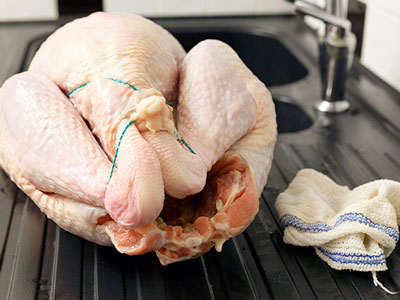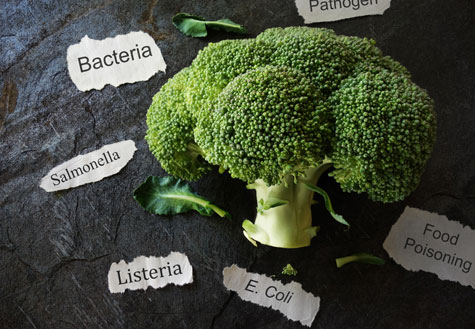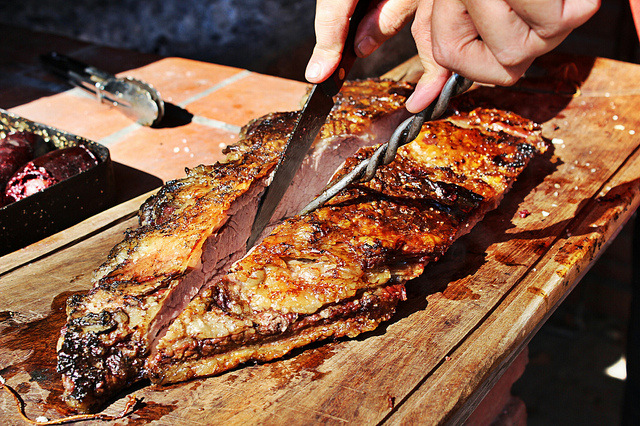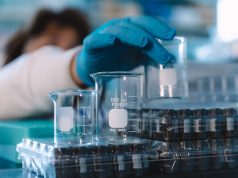by Alicia Rohan
UAB News

Parties and gatherings are typically centered around food, making it important to know the do’s and don’ts of handling food.
Bernard Camins, M.D., associate professor in the Division of Infectious Diseases at the University of Alabama at Birmingham, provides answers to some common questions.
Q: What are the types of bacteria found in food that affect our digestive systems?
The main types of bacteria found in food are salmonella, E. coli, shigella, Bacillus cereus, listeria and campylobacter.
These bacteria are more likely to affect children, senior adults and those with compromised immune systems.
Salmonella, shigella, campylobacter and pathogenic E. coli are bacteria that are found in raw meat, contaminated produce, and other contaminated food and water. They produce toxins that can cause intestinal diseases, with the main sign being watery diarrhea that can sometimes be bloody.
Bacillus cereus, or B. cereus, is a spore-forming organism that makes an infectious toxin. When foods like rice and pasta are contaminated with B. cereus and not cooked thoroughly the first time, the spores have not been eliminated. As the food cools to below 122 degrees Fahrenheit, the spores germinate and start producing toxin, causing symptoms when ingested. This often occurs in starch-based foods, such as potatoes, rice and pasta.
Listeria is bacteria most commonly found in soil. It is carried in the intestinal tract of 5 to 10 percent of humans who are asymptomatic. The bacteria primarily affects pregnant women, senior adults, babies and people who are immunosuppressed.
Q: Where do food-borne bacteria come from?
Bacteria like Bacillus cereus or listeria can be found in soil and the environment. Staphylococcus is on people’s skin or noses and can be transferred from a carrier. E. coli, shigella and salmonella come from fecal contamination of food, which then is transmitted orally.
“Not properly washing your hands after being contaminated is a common cause of bacterial contamination leading to fecal to oral contamination,” Camins said.
Q: Why do we get sick from eating certain foods?
Most foods will have certain bacteria; but not every food is contaminated with pathogenic bacteria, or bacteria that can make you sick. Pathogenic bacteria that multiply or create a toxin are what makes one ill.
“Acid in the stomach can retard bacterial growth,” Camins said. “It’s the infectious dose of bacteria that makes us sick, and certain bacteria require different doses.”
For example, shigella is known to have a low infectious dose, meaning only a few organisms can make you sick, compared to salmonella, which requires a higher dosage to make you sick.
Q: What are the most common foods that carry food-borne illnesses?
Most foods that are cooked or kept at appropriate temperatures are safe to eat. However, any food that has been contaminated poses a risk of infection or illness. Fruits and vegetables that are contaminated and not kept cold can allow pathogenic bacteria to flourish.
Mayonnaise and icing are a vehicle for staphylococcal-mediated food poisoning. Since these are not cooked, it is hard to get rid of the toxin once the product is contaminated. Keeping products cool does not help, because it has already been contaminated. The best prevention is to wash kitchen utensils well before using them to make the cake, salad or sandwiches.
Cookie dough is risky, due to raw eggs’ being a source of pathogenic E. coli or salmonella, until they are cooked at the correct temperature.
“It’s not the staph infection itself that makes us sick, but the toxin it produces,” Camins said. “Outbreaks are often associated with icing from cakes, coleslaw and potato salad.”
Starch-based foods that are reheated are a risk. Someone who eats pasta while it is warm may not be affected. However, if someone comes back once the pasta has cooled, allowing time for toxin to be generated, they could encounter B. cereus toxin and become ill.
Meats are typically safe once they have been cooked, killing the bacteria. Cured meats, like hot dogs and salami, have been linked to outbreaks of listeria. The danger for meats comes from cross-contamination or contamination from a carrier, such as a contaminated knife that has not been washed thoroughly or a food preparer who has not washed their hands.
Turkey is a good example of meat that is contaminated when raw. Sometimes even if it is cooked thoroughly, people still get sick from eating it. This is because of cross-contamination. Did you properly wash the knife you used to cut into the raw turkey? If it was not washed properly and then used to cut the cooked turkey, the bacteria from the contaminated knife will be transferred to the cooked meat.
Q: Does food temperature matter? How long can you leave something out without its being refrigerated or kept warm?
The issue is not with leaving food out too long. The question is whether the food has been contaminated with bacteria and whether the conditions are ripe for the bacteria to flourish. Certain bacteria flourish when food is contaminated and not kept at the appropriate temperature.
“Not keeping foods at the appropriate temperature is not always a danger,” Camins said. “The danger comes from pathogenic bacteria’s multiplying if they are present — how much grows and if it starts to multiply to an infectious level.”
Any foods that are chilled and have never been cooked are at a higher risk of carrying bacteria. Fruits and vegetables may carry pathogen bacteria. Even if you have washed it thoroughly, you should keep it chilled. If it is not chilled, this provides an ideal environment for the bacteria to grow and multiply into an infectious level.
Salmonella and pathogen E. coli have been known to contaminate lettuce. The warmer the temperature, the more ideal it is for the bacteria to grow. Eating a large amount of lettuce or salad with higher amounts of the bacteria could cause the infection.

Q: What are the signs and symptoms of food-borne illness? How should it be treated?
Depending on which bacteria the food is contaminated with, one may experience one or all of these symptoms: nausea, vomiting, watery or bloody diarrhea, and/or fever.
“For the most part, the toxins will work themselves out within 24 hours,” Camins said. “You will just be sick and uncomfortable, but there are not any serious dangers unless someone has a compromised immune system.”
Depending on the pathogen, food-borne illnesses are self-limiting and one will recover within 24 to 72 hours. Once the body has dispensed the bacteria or toxin, the body will recover.
If you experience symptoms for more than three days, become dehydrated, dizzy, pass out or have a fever for more than 24 hours, you should see a physician.
“Hydration is more important than food, and the key to recovering from a food-borne illness,” Camins said. “If you can’t keep anything down, you should see a physician.”
Q: What risks are associated with food-borne illnesses?
Most at risk are senior adults, babies and those who are immunosuppressed. Senior adults and babies are at a higher risk of dehydration, which can be harmful.
“Babies and senior adults do not always know when they are thirsty and cannot necessarily tell their caretaker,” Camins said. “They cannot always voice their symptoms, so it is important to make sure they stay hydrated.”
People with diabetes, cancer, lupus, rheumatoid arthritis, Crohn’s disease and other immunologic diseases are at risk of serious complications when it comes to food-borne illness. The bacteria could get into their bloodstream or settle in their bones, affecting their diseases further.
“Bacterial food infections often cause patients suffering, but are not always deadly,” Camins said.
A particular strain of E. coli (O157:H7) and shigella can cause a rare complication called hemolytic uremic syndrome, which is when clots form in the very small vessels, blocking circulation to kidneys and brain and causing kidney failure and/or confusion. One may experience bloody diarrhea from HUS.
Q: What can people do to prevent food-borne illnesses?
Hand hygiene is the most effective way to prevent food-borne illnesses. People should wash their hands after using the restroom, before preparing food, after touching raw meat and before preparing anything that is uncooked.
“Using soap and water is the best way to eliminate bacterial contamination,” Camins said. “If soap and water is not available, such as at an outdoor picnic or tailgate, alcohol gel is a good way to disinfect the hands.”
In addition to washing your hands, Camins suggests:
- Keep uncooked food at the right temperature to reduce bacterial growth.
- Separate clean and contaminated dishes in the sink.
- Keep items that are potentially contaminated like raw meat separate.
- Wash all fruits and vegetables.
- Wear disposable gloves when preparing food.
“Know the limits of where you are bringing food items,” Camins said. “Think about what is appropriate and how it will be handled and kept cool or warm. Food safety can help us all stay well.”





